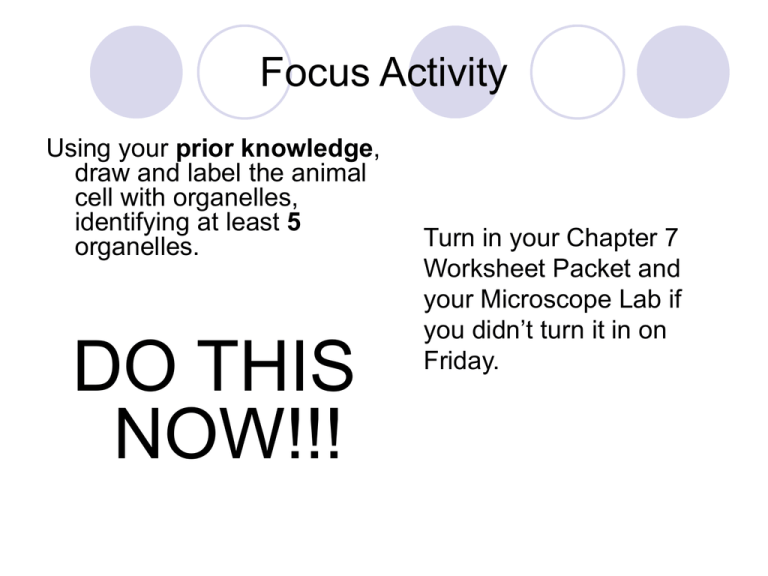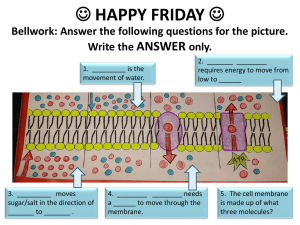Cells - Fort Bend ISD
advertisement

Focus Activity Using your prior knowledge, draw and label the animal cell with organelles, identifying at least 5 organelles. DO THIS NOW!!! Turn in your Chapter 7 Worksheet Packet and your Microscope Lab if you didn’t turn it in on Friday. Cellular Life “Can you hear me now?” Good. Ch. 7: Cell structure and function In the book, chapter 7 is about cells and cell functions. Why do you think it is important to learn about cells? Throughout this chapter try to relate information from Chapter 2 to the information that you will be getting today and tomorrow. Ch. 7: Section Outline 7-1: Life is Cellular The Discovery of the Cell Exploring the Cell Prokaryotes and Eukaryotes 7-2: Eukaryotic Cell Structure Organelles 7-3: Cell Boundaries Cell Membrane and Cell Walls Diffusion and Osmosis 7-4: The Diversity of Cellular Life Unicellular and Multicellular Organisms Levels of Organization The Discovery of the Cell Robert Hook Use a medieval microscope to look at a piece of cork. First person to identify cells Discovery of the Cell (con’t) Anton van Leeuwenhoek First person to observe living cells It was he who discovered bacteria, free-living and parasitic microscopic protists, sperm cells, blood cells, microscopic nematodes and rotifers, and much more. The Discovery of the Cell (con’t) Cells: the basic unit of life The Cell Theory: All living things are composed of cells Cells are basic units of structure and function in living things New cells come from existing cells Prokaryotes and Eukaryotes Prokaryotes: cells that don’t have a nucleus. Name means “Before Nut” Small and simple Free-floating genetic material Ex: Bacteria Eukaryotes: cells that have a nucleus Name means “True Nut” Large and complex Contain membrane bound structure Nucleus: large, membrane enclosed structure that contains genetic material. Prokaryote vs Eukaryote Cell membrane Cytoplasm Prokaryotic Cell Cell membrane Cytoplasm Nucleus Eukaryotic Cell Organelles 7-2 Eukaryotic Cell Structure Organelles: membrane bound structures within a cell; “little organs” 2 main parts of a cell: Nucleus Cytoplasm: portion of cell outside of nucleus that contains the organelles suspended in a liquid called cytosol. Organelles When you are writing your notes, think of analogues in the body that could represent each organelle. Nucleus The control center of the cell Contains almost all of a cell’s DNA Contains the Nucleolus Nuclear Envelope: Membrane that surrounds the nucleus Chromatin: Long, stringy DNA bound to proteins Organelles (con’t) Chromosomes: compact DNA (made when a cell is about to divide) What is the difference between chromatin and chromosomes? Nucleolus: Inside the nucleus, it’s function is the production and maturation of ribosomes. Ribosomes The site for protein synthesis Made from RNA and proteins Organelles (con’t) Endoplasmic Reticulum Name means “within the cytoplasm little net” Internal membrane system Lipids assembled here Proteins made to leave the cell come here too. Two types Rough Endoplasmic Reticulum Smooth Endoplasmic Reticulum Organelles (con’t) Rough Endoplasmic Reticulum Ribosomes are found on the surface. They chemically modify proteins Smooth Endoplasmic Reticulum No Ribosomes are found on the surface. Synthesizes lipids, fatty acids, and steroids Plays an important part in Carbohydrate metabolism Enzymes in the Smooth ER detoxify drugs Organelles (con’t) Golgi Appartus The Packaging center Modifies, sorts, and ships proteins that come from the ER (sends them where they need to go) Lysosomes Small, filled with enzymes Do the “digesting” of the cell Breakdown proteins, lipids, etc., and old organelles Organelles (con’t) Vacuoles Saclike structures used for storage Pump out water Store water (plants-central vacuole) Mitochondria and Chloroplasts Source of Energy Organelles (con’t) Mitochondria Organelles that convert chemical energy stored in food into ATP Enclosed by two membranes • Outer • Inner (folded inside) Inherited from egg cells Chloroplasts Organelles that capture energy from sunlight and convert it into chemical energy and sugar Found only in plants Mitochondria and chloroplasts contain their own small DNA Molecules (genetic info) Organelles (con’t) Cytoskeleton The support system of a cell Made of protein filaments that help maintain shape of a cell (ex. Microtubules and microfilaments) The cytoskeleton is also a part of movement for a cell. Microtubules help build cilia and flagella. Cytoskeleton Cell membrane Endoplasmic reticulum Microtubule Microfilament Ribosomes Mitochondrion Organelles Special Organelles Some organelles are only found in plants and only found in animals Chloroplasts (plants) Centrioles (animals) Centrioles Important in cell division Creates Microfilaments that attach to chromosomes to separate the replicated DNA. 7-3: Cell Boundaries This chapter talks about the boundaries of the cell. You will also learn about diffusion and the different types Active and passive Transport Facilitated Diffusion Osmosis Endocytosis and Exocytosis 7-3: Cell Boundaries Cell Membrane The thin, flexible barrier that surrounds all cells Some cells have another layer outside this called a cell wall. Function: Regulates what enters and leaves cells Provides protections Structure Lipid Bilayer: Double layer of phospholipids • Fluid Mosaic Model Carbohydrates attached to outside bilayer Proteins found within it Lipid Bilayer Outside of cell Proteins Carbohydrate chains Cell membrane Inside of cell (cytoplasm) Protein channel Lipid bilayer Cell Boundaries (con’t) Cell Walls Found in plants, fungi, and some prokaryotes Outside of cell membrane Functions SUPPORT! SUPPORT! SUPPORT! Protection Made from carbohydrates (cellulose) and proteins Animal Cell The Cell (plant) Diffusion Through Cell Boundaries Concentration: The mass of solute in a given volume of solution ex: 4g/L Cytoplasm contains different concentration of different solutes Particles in a solution are constantly moving and tend to spread out evenly Brownian Movement Diffusion through Cell Boundaries Diffusion: the movement of particles from an area of high concentration to an area of low concentration Equilibrium: When the concentration gradient of a solute is the same throughout a system *Diffusion requires no energy and is called “Passive Transport”* Particles diffuse across cell membranes Semi-permeable membrane Osmosis Osmosis The diffusion of water across a selectively permeable membrane (again a type of Passive Transport) WATER moves from an area of low particle concentration to an area of high particle concentration. Isotonic Hypertonic Hypotonic Tonicity Osmosis Facilitated Diffusion Facilitated Diffusion The Process of particles moving down their concentration gradient (high to low) with the help of a protein channel Does not require energy (passive) Protein channels are specific in which molecules they aid Facilitated Diffusion Glucose molecules High Concentration Cell Membrane Low Concentration Protein channel Active Transport Active Transport The movement of particles against the concentration gradient-requires energy Carried out by protein “pumps” Very Large molecules (too big to cross the membrane), move by endocytosis and exocytosis. Active Transport Molecule to be carried Energy Molecule being carried Active Transport (con’t) Endocytosis The process of taking in material by means of infoldings or pockets of the cell Exocytosis The membrane of a vacuole, containing water, fuses with the cell membrane (spilling the contents out) Phagocytosis Cell “eating” Pinocytosis Cell “drinking” 7-4: The Diversity of Cellular Life Sometimes a single cell IS the whole organism. Single-celled organisms are called unicellular organisms. Can you name any? Unicellular Organisms The Diversity of Life Organism that are made up of many cells are called multicellular organism Cell Specialization The Process of cell’s becoming specific for a certain tasks Red Blood Cells, muscle cells Cell Specialization occurs in multicellular organisms. What are Stem Cells? Levels of Organization In multicellular organisms, there are levels of organization used to describe cells: Cells the simplest level Tissues- groups of cells that work together to perform a particular function Organs-groups of tissues that work together Organ Systems – Groups of organs that work together Level of Organization Muscle cell Smooth muscle tissue Stomach Digestive system









